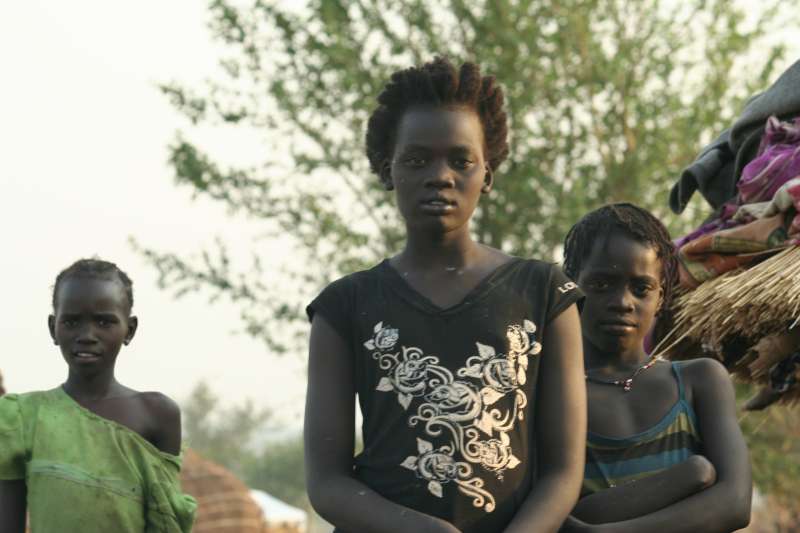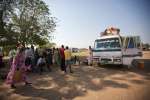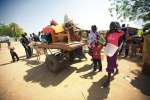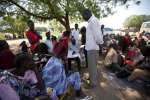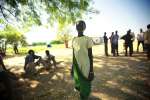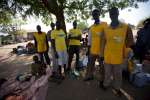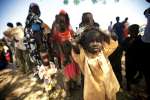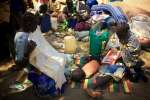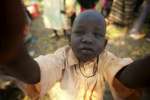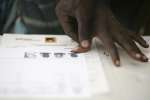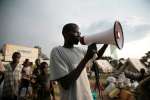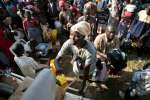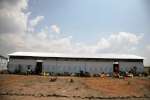- Text size
 |
|  |
|  |
| 
- عربي
Home Alone: South Sudan teenager leads her young siblings to safety in Uganda
Telling the Human Story, 4 September 2014
BOROLI REFUGEE SETTLEMENT, Uganda, September 4 (UNHCR) – When 13-year-old Yayo Tangko turned up at the Boroli refugee settlement in Uganda earlier this year with her four younger siblings, she feared the worst for her missing parents. "They are dead, because otherwise they would have come looking for us," the South Sudanese teenager told aid workers.
It turned out she was wrong and the children would eventually be reunited with their mother. But the aid workers were impressed at the girl's strength and determination in bringing her sister and three brothers to safety after conflict flared between government forces and rebels in South Sudan at the end of last year.
When the fighting came to Pibor county, where they lived, their parents were away at a market. Kept together by Yayo, the children were swept along by the mass of humanity flowing out of Jonglei and into Adjumani and other districts of northern Uganda.
They walked for days, with the older children taking turns to carry two-year-old Babur when he was too exhausted to walk. Other refugees shared food with the youngsters and protected them until they reached the border crossing at Elegu, where they were picked up and taken to the Dzaipi transit centre.
In such emergency situations, UNHCR and its partners are always looking out for children travelling alone or separated from their families. In the chaos of flight, it is easy to get lost from family, and children are particularly vulnerable during mass population displacements.
Yayo and her young charges arrived at Dzaipi tired and relieved to be out of harm's way. But life in the overcrowded transit centre was difficult. In early February, after almost a month at Dzaipi, they were transferred to the Boroli refugee settlement, where Save the Children gave them a tarpaulin for a simple shelter.
The Geneva-based Lutheran World Federation, another UNHCR partner, assigned them a guardian, Kitho, who was from the same ethnic group as the children and did much to help and advise them. But Yayo and her sister, 11-year-old Yotok, had to grow up quickly to take care of their siblings.
Despite getting vital help from Save the Children and the Lutheran World Federation, they were not getting enough food and they struggled to cook what they did have on an open fire. Moreover, when the rains started in March, the tarpaulin was not enough to protect them – they needed something more durable.
When their food (mainly pulses and porridge) ran out, they depended on the generosity of their neighbours. UNHCR staff first met the children in February, and their hardship was clear. They found Babar chewing ugali, a kind of porridge made from cornmeal, but he was showing signs of malnutrition.
A UNHCR nutrition officer brought fortified biscuits, clothes and blankets, and referred Babar to a clinic so that he could be treated for malnutrition.
The UN refugee agency worked with the Lutheran World Federation to build a traditional dwelling, a tukul, for the children. Save the Children gave them a new tarpaulin, blankets, sleeping mats, clothes, kitchen goods, health and sanitation items, and also introduced them to other children and a special play area. "Now we feel safe. We can come out and play," said Yayo, who still missed her parents. .
Efforts were launched by UNHCR and its partners, including the Uganda Red Cross Society and the International Committee of the Red Cross (ICRC), to trace family members. But Yayo again showed her initiative by asking a refugee who was returning to South Sudan to take Babur and Kobrin, aged five, with him in May to see if they could find relatives to take care of them.
A few weeks later, the two youngsters were reunited with their mother, Mary, at a site for internally displaced people in South Sudan. Yayo talked with her mother by phone and, in early June, Mary and the two boys moved to Boroli. The father is reportedly fighting as a soldier.
The younger children benefit from Save the Children nursery school programmes, but Yayo cannot yet go to school because she must help look after the family. Maybe, with her mother back, she can start studying soon.
Having most of the family together helps to make up for the hardship of being a refugee, and at least they are safe and can hope for a better future in a country which allows refugees a great deal of freedom. Uganda currently accommodates about 400,000 refugees, including 137,000 from South Sudan.
By Dorothy Lusweti in Boroli Refugee Settlement, Uganda
